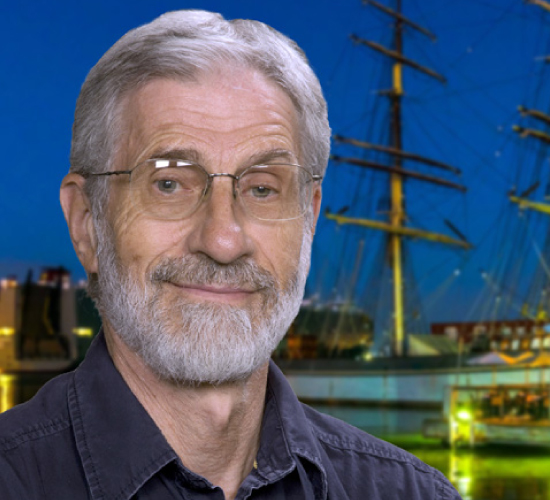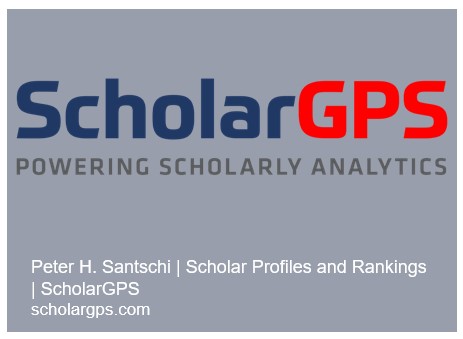M.S. Chemistry, University of Berne, Switzerland, 1971
B.S. Science and Economics, Gymnasium Berne, Switzerland, Matura 1963
Regents Professor Emeritus and University Distinguished Professor Emeritus
Department of Marine and Coastal Environmental Science

"Not everything that can be counted counts, and not everything that counts can be counted".
-Albert Einstein, 1879 - 1955
Thanks to having had good teachers in high school (gymnasium), they got me interested in the Natural Sciences. I strongly felt that Nature had laws that were more worthy of study than human laws. That led me on a path with multiple zig-zags. When it was time to decide what field to study in the University of Bern in Switzerland, I veered from astronomy to physics to chemistry. In 1970, when it was the time to decide on a topic for a PhD thesis in chemistry, my top choices were blood chemistry and aquatic chemistry. I then opted for Aquatic Chemistry, as I felt that at that time one could do more pioneering work in that field. When I applied for a postdoc position in the USA, I had 3 offers, including from one from WHOI, but decided to work with Wally Broecker in Geochemistry at Lamont-Doherty Earth Observatory (LDEO) of Columbia University to carry out environmental research in geochemistry and environmental radiochemistry. After 6 years doing research in the USA, I spent 6 years as a section head in Isotope Geochemistry/Radiology at EAWAG (Swiss Institute of Water Research) and lecturer (Privatdozent) in geochemistry at ETH (Swiss Institute of Technology) in Zurich, Switzerland. This allowed me to learn more about other disciplines in environmental science, and this knowledge allowed me then to get a head start in my research ventures when moving again across the Atlantic to obtain continued research funding from federal agencies since 1988 at TAMUG. Since moving here, I again had to reinvent, refocus, and retool myself, and my current research now evolves around the question of what organic carriers are moving radiochemicals and other pollutants through environmental systems, which requires us to combine environmental radiochemistry and geobiology with environmental organic chemistry approaches and techniques.
I expect that the students working with me learn to think critically. That requires them to be able to connect with and apply principles from basic science to a variety of analytical and theoretical fields such as environmental and marine chemistry, radiochemistry, and biochemistry, which they are learning from me. This will allow them to become independently thinking scientists that can take advantage of new opportunities as they come along. For example, while quite a number of my graduate students became professors, teachers and researchers themselves, many work for industry, national laboratories or agencies, or are heading large environmental organizations.
With my 75 years on this earth, I am still trying to stay active both physically and mentally, exercising to recover from a septic hip operation in Nov. 2016. My daily Taichi and Qigong exercises that I continue to practice and learned from a grandmaster here in Galveston help me a great deal in this recovery by harmonizing body, breath and mind. In addition, daily practice of meditation and Eastern Philosophies (e.g., Taoism, Buddhism, etc.) helps to keep me centered in the NOW.
I lead a relatively large group of researchers at TAMUG which is one of the best group of people that I ever worked with. Just like the ecological teamwork of autopoietic systems, successful research in environmental systems requires not only self-replication, i.e., new students that practice the science, but also synergistic teamwork. Thus, much of what I accomplish now is really carried out by members of a closely interacting team of researchers. These researchers share my passion to learn more about the blue print of nature as it applies to how chemical systems within ecosystems adjust to multiple stressors in the environment in order to apply this to the study of fate and effects of human produced chemicals and radiochemicals in the environment.
CHEM 383: Environmental Chemistry
CHEM 464: Nuclear Chemistry
MARS 340: Geochemistry
MARS 430: Geological Oceanography
MARS 440: Chemical Oceanography
MARS 481: Seminar in Marine Science
MARS 491: Research, Environmental Geology
OCNG 644: Isotope Geochemistry
OCNG 681: Seminar in Oceanography/Marine Science
OCNG 646: Dynamics of Environmental Colloids
Geochemical Oceanography
Radioactivity in the Environment
Environmental Colloids
Marine Organic Chemistry
Marine Colloids Chemistry
Marine Radiochemistry
Marine Biogeochemistry

Honeyman, B.D., and Santschi, P.H. 1989. A Brownian-pumping model for trace metal scavenging: evidence from Th isotopes, J. Mar. Res., 47/4, 950-995.
Wen, L.S., P.H. Santschi, C. Paternostro, and G. Gill. 1999. Estuarine trace metal distributions in Galveston Bay I: Importance of colloidal forms in the speciation of the dissolved phase, Mar. Chem., 63 (3-4), 185-212.
Guo, L., and Santschi, P.H. 2000. Sedimentary sources of old high molecular weight dissolved organic matter from the ocean margin benthic nepheloid layer. Geochim. Cosmochim. Acta, 64(4), 651-660.
Santschi, P.H., Guo, L., Asbill, S., Allison, M., Kepple, B., and Wen, L.-S. 2001. Accumulation rates and sources of sediments and organic carbon on the Palos Verdes shelf based on multiple radioisotopic tracers (137Cs, 239,240Pu, 210Pb, 234Th, 238U and 14C). Marine Chemistry, 73(2), 125-152.
Tang, D., Warnken, K.W., and Santschi, P.H. 2001. Organic complexation of Copper in surface waters of Galveston Bay. Limnol. Oceanogr., 46(2), 321-330.
Verdugo, P., Alldredge, A.L., Azam, F., Kirchman, D.L., Passow, U., and Santschi, P.H. 2004. The oceanic gel phase: a bridge in the DOM-POM continuum. Mar. Chem., 92, 67-85.
Xu, C., Zhang, S., Kaplan, D.I., Ho, Y.-F. , Schwehr, K.A., Roberts, K.A., Chen, H.M., Didonato, N., Athon, M.*, Hatcher, P.G., Santschi, P.H. 2015. Evidence for Hydroxamate Siderophores and Other N-Containing Organic Compounds Controlling 239,240Pu Immobilization and Remobilization in a Wetland Sediment. Environ. Sci. Technol., 49, 11458−11467.
Santschi, P.H., Xu, C., Schwehr, A.K., Lin, P., Sun, L., Chin, W.-C., Kamalanathan, M., Quigg, A. 2020. Can the protein/carbohydrate (P/C) ratio of exopolymeric substances (EPS) be used as a proxy for its ‘stickiness’ and other biophysical properties? Perspective article in Marine Chemistry, https://doi.org/10.1016/j.marchem.2019.103734.
Sun, L., Chin, W.-C., Chiu, H.-H., Xu, C., Lin, P., Schwehr, K.A., Quigg, A., Santschi, P.H. 2021. Sunlight induced aggregation of protein-containing dissolved organic matter (DOM) in the coastal ocean, Marine Chemistry, https://doi.org/10.1016/j.marchem.2020.103907.
Xu, C., Goranov, A.I., Kaplan, D.I., Lin, P., Yeager, C.M., Patterson, N., Jiang, H., Ware, S., Hatcher, P.G., Santschi, P.H. 2024. Molecular features of uranium-binding natural organic matter in a DOE site using ultrahigh resolution mass spectrometry. STOTEN 174867, https://doi.org/10.1016/j.scitotenv.2024.174867
2012: Invited Presentation “Biopolymers as carriers of radionuclides in marine aggregates" at the International Workshop on Marine Aggregates (IWOMA) - From Molecular principles to Biogeochemical Impacts (August 15-17, 2012), in Bremen, Germany.
2013: Presentation at the International Goldschmidt 2013 Conference (August 25-30, 2013) in Florence, Italy.
2014: Invited Presentation at the Ocean Sciences Meeting (February 23-28) in Honolulu, HI.
2014: Invited Presentation at the International Goldschmidt 2014 Conference (June 8-13, 2014) in Sacramento, CA.
2014: Invited Presentation at the International Plutonium Futures Conference (September 7-12) in Las Vegas Nevada.
2015: Invited Keynote Speaker at The International Conference on Contaminated Sediments, Environmental Chemistry, Ecotoxicology and Engineering, ContaSed
2015: 8–13 March 2015, Congressi Stefano Franscini in Monte Verità, Switzerland, organized by the Swiss Institute of Technology, ETH Zurich.
2016: Invited Keynote Speaker at the International Goldschmidt Conference in Yokohama, Japan, June 26 - July 1, 2016, in the Session "Biological Transformation and Fate of Natural and Anthropogenic Radionuclides in the Environments”.
2016: Presenter and Member of Scientific Committee of ICRM-LLRMT (International Committee for Radionuclide Metrology – Low Level Radioactivity Measurements Techniques) conference, Seattle (WA, USA) September 26-30, 2016.
2016: Organizer of special ACS Symposium on “Chemical and Biological Processes Regulating Transport of Pollutants in the Gulf of Mexico and Its Estuaries” at the 72nd Annual Southwest Regional Meeting (SWRM), Galveston, TX, November 10-13, 2016.
2017: Session Co-Organizer, Co-Chair and presenter at the Gulf of Mexico Oil Spill and Ecosystem Science Conference 2017, New Orleans, LA. February 6-9, 2017.
National Science Foundation – Chemical Oceanography, “Biopolymers produced by diatoms and coccolithophores as carriers for selected natural radionuclides (of Th, Pa, Pb, Po, Be) in the ocean”, Peter H. Santschi, PI, Quigg, A., Schwehr, K.A., and Xu, C., co-PIs, Feb. 1, 2014 – Jan. 31, 2018 ($506,849).
DOE, Office of Science, SBR, “Collaborative Research: The Importance of Organo-Iodine and Iodate In Iodine-127,129 Speciation, Mobility and Microbial Activity in Groundwater at DOE Sites”, Santschi, P.H., PI, 2014-2015 ($60,000 supplement to TAMUG).
Gulf of Mexico Research Initiative (GoMRI), “Role of microbial exopolymers in aggregation and degradation of oil and dispersants”, Santschi, P.H. (Deputy Director and PI), with Quigg, A. (Consortium Director), and Knapp, T., Wade, T.L., Chin, W.-C., Passow, U., Hatcher, P.G., Silvan, J., and Finkel, Z. (co-PIs), Jan. 1, 2015 – Dec. 31, 2017 ($7,245,432 total, $3,209,495 to TAMUG).
DOE, Office of Science, SBR, “Collaborative Research: Natural Organic Matter and Microbial Controls on Mobilization/Immobilization of I and Pu in soils in USA and Japan”, Santschi, P.H. PI, Xu, C., Schwehr, K.A., and Zhang, S., Kaplan, D.I., and Yeager, C.M., co-PIs, Aug. 1, 2015-July 31, 2018 ($600,000 total, $300,000 to TAMUG).
DOE, PNNL, “Post Detonation Maritime Collection and Analysis paper study”, subcontract from PNNL, Santschi, P.H., PI, 2016 ($20,000 to TAMUG), March 28, 2016 through September 30, 2016.
DOE, NEUP, Office of Nuclear Energy “Using Radioiodine Speciation to Address Environmental Remediation and Waste Stream Sequestration Problems at the Fukushima Daiichi Nuclear Power Plant and a DOE Site”, Santschi, P.H., PI ($420,000 to TAMUG), Oct.1, 2016-Sept. 30, 2019.
DOE, LDRD, “Silver-iodine Secondary Waste Stabilization: Multiscale Evaluation”, Santschi, P.H., PI ($40,000 to TAMUG, subcontract from SRNL), January 1, 2017 - September 30, 2017.
DOE, subcontract from SRNS, “Radioiodine Speciation on G-SOW-A-01859 Waste Form Stabilization (SRNS RFP No.0000318991)”, Santschi, P.H., PI, ($40,000 to TAMUG), 2017-2018 ($40,000 to TAMUG, subcontract from SRNL).
Amec Foster Wheeler Environment & Infrastructure, Inc., fixed price contract for court-mandated study, “Radiochemical Analyses of sediments from the Penobscot River”,
Santschi, P.H., PI, ($177,600 to TAMUG), Sept. 30-Dec. 31, 2017.
Gulf of Mexico Research Initiative (GoMRI), “ADDOMEx 2: Towards a synthesis of processes and pathways of marine oil snow formation”, Santschi, P.H. (Deputy Director and PI), with Quigg, A. (Consortium Director), and Knapp, T., Wade, T.L., Chin, W.-C., Passow, U., Hatcher, P.G., Silvan, J., and Finkel, Z. (co-PIs), Jan. 1, 2018 – Dec. 31, 2019 ($2.54 Million total).
DOE, LDRD, “Silver-iodine Secondary Waste Stabilization: Multiscale Evaluation”, Santschi, P.H., PI ($40,000 to TAMUG, subcontract from SRNL), January 1, 2018 - September 30, 2018.
2017: Elected Geochemical Fellow of the Geochemical Society and the European Association of Geochemistry.
2014: Elected a Fellow of the American Geophysical Union.
2013: Environmental Science and Technology Outstanding Reviewer Recognition (2013).
2013: Association of Former Students Distinguished Achievement Awards in Graduate Student Mentoring from Texas A&M University.
2009: Regents Professor of Texas A&M University.
2004: Association of Former Students Distinguished University Level Achievement Award for Research from Texas A&M University.2004. Limnology and Oceanography Outstanding Reviewer Recognition.
Peter H. Santschi
Regents Professor Emeritus and University Distinguished Professor Emeritus
Department of Marine and Coastal Environmental Science
1001 Texas Clipper Rd
Bld# 3029, Office 346
Galveston, TX, 77554 USA